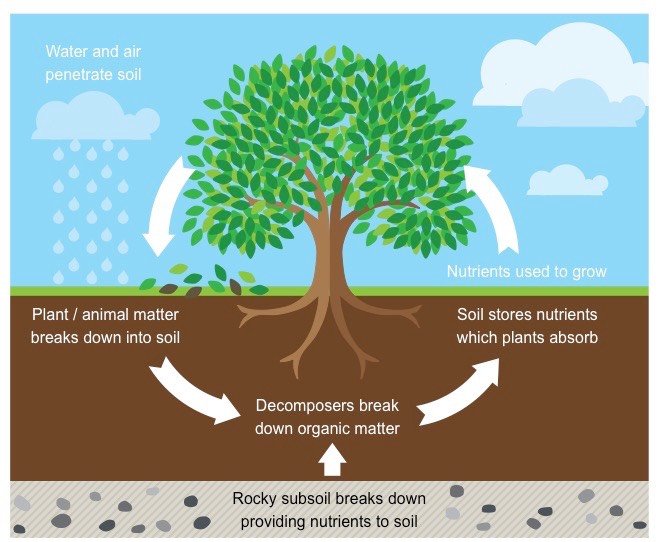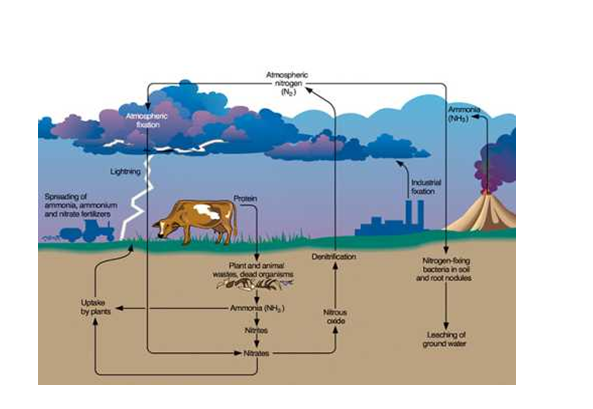Back to: BIOLOGY SS2
Welcome to Class !!
We are eager to have you join us !!
In today’s Biology class, We will be learning about Nutrient Cycles in Nature. Today we will be focusing on the Nitrogen Cycle. We hope you enjoy the class!

CONTENT
- Definition
- Process of cycling
- Importance of Nitrogen
- Decomposition in nature
- Types of decomposers (Micro and Macro decomposers)
- Roles of decomposers
Nitrogen Cycle
Nitrogen is an abundant element in the atmosphere. It is an essential constituent of proteins, a group of substances found in all living cells. About 78% of air is composed of gaseous nitrogen. Plants cannot incorporate nitrogen gas into organic compounds and therefore depend on various types of bacteria to make nitrogen available for them in a global cycle called the nitrogen cycle. In nature, nitrogen is constantly being removed from the soil and returned to it via the nitrogen cycle.
Conversion of Gaseous Nitrogen into Nitrogenous Compounds
Gaseous nitrogen is converted into nitrates in the following ways
- The action of thunderstorms
- Nitrogen-fixing microorganisms
During thunderstorms, nitrogen reacts with oxygen to form nitric oxide. The nitric oxide is oxidized to nitrogen peroxide which dissolves in rainwater to form nitric nitrous acids. When these acids enter the soil, they combine with mineral salts to form nitrates. The nitrates then dissolve in soil water and are absorbed by the plants. These nitrates are converted into plant proteins and become part of the plant body (assimilated). The organisms capable of splitting the nitrogen molecule and use it to form nitrites or nitrates is known as nitrogen fixation. Some microorganisms are able to change gaseous nitrogen directly into proteins.
Types of Nitrogen-fixing Microorganism
- Free-living organism.
- Symbiotic organism.
Azotobacter and Clostridium are free-living bacteria. They are able to absorb nitrogen from the atmosphere and change it into amino compounds and proteins. The energy needed for these processes is obtained from the breakdown of carbohydrates in humus. Symbiotic bacteria like the Rhizobium which are found in the root nodules of leguminous plants use gaseous nitrogen to manufacture amino compounds and proteins which they share with the host plants. These bacteria get the energy needed for nitrogen fixation from the breakdown of carbohydrates in the host’s tissues. When the host plants die, the amino compounds and proteins in the root nodules are converted to soil nitrates.
Evaluation
- What is the nitrogen cycle?
- Explain the types of nitrogen fixation.
Putrefaction: Plants are the food producers in nature; animals feed on plants and convert plant proteins; to animal proteins. When these animals are eaten by carnivorous animals, more animal proteins are formed. Proteins are decomposed through amino acids to ammonia when an organism dies. The nitrogen that is trapped in the bodies of all these living organisms re-enters the nitrogen cycle through putrefaction or decay. When living organisms die, they decay and the excretory product also decays.
Ammonification: The putrefying bacteria and fungi are responsible for decay. These saprophytic organisms convert plant and animal materials into simple substances like carbon dioxide, water, and ammonia. This breakdown of protein into ammonia is known ammonification.
Nitrification: Animal wastes and excreta are decomposed and the chemosynthetic bacteria then oxidize ammonia to nitrites and the nitrites are converted to nitrates by nitrifying bacteria. This process is called nitrification.
Denitrification: Denitrifying bacteria in the soil convert nitrates into gaseous nitrogen which escapes into the atmosphere. This reduces the nitrogen content and fertility of the soil.
Evaluation
- What is nitrification?
- Explain denitrification.
Decomposition in Nature
Decomposition is the process by which organisms, mainly bacteria and saprophytes break down dead organic materials which could be of plant or animal origin.
Types of Decomposers
- Micro decomposers: These are small or microscopic organisms that can cause decay e.g. certain bacteria and fungi.
- Macro decomposers: These are bigger organisms that can cause decay of dead organic materials e.g. earthworms, termites, snails, mushroom, toadstools, etc.

NITROGEN CYCLE
Process of Decomposition
The decomposers secrete enzymes onto their food source such as decaying dead organisms. These enzymes break down complex organic compounds (food) like carbohydrates into simple soluble inorganic Compounds. A lot of the chemical energy in the compounds is lost as unstable heat energy. The decomposers only absorb a small number of nutrients and energy for their use. The rest is released into the soil, air and water. When decomposers die, other decomposers feed on them, the nutrient released is used by plants to manufacture their food. Products released during decomposition are gases such as carbon dioxide, hydrogen sulphide, ammonia and water vapour. Others are heat energy and nutrients such as nitrates, sulphates, phosphate, ions, etc.
Role of Decomposers
- They enrich the soil with nutrients required for plant growth
- They contribute to environmental pollution.
- Decomposition is useful in the making of cheese and yoghurt.
- They allow the ecosystem to function by enabling the recycling of nutrients.
- They also prevent an unsightly accumulation of remains and wastes of living organisms on the earth surface.
General Evaluation
- Write on the two types of decomposers.
- State the roles of decomposers.
- What is autotrophic nutrition?
- List the two modes of autotrophic nutrition.
- Differentiate between the two modes listed above.
Reading Assignment
College Biology by idodo Umeh. Chapter 23, page 556-558
WEEKEND ASSIGNMENT
- Legumes incorporate nitrogen gas into their proteins because (a). of the presence of Azotobacter in their roots (b) they possess root nodules containing Rhizobium (c) they have a well-developed root system (d) they are autotrophic.
- Thunderstorms can be beneficial to plants because (a) it kills the pest that attacks crops (b) it destroys some of the major crops (c) it adds nitrate to the soil (d) it makes rainwater available to plants.
- Which of the following is responsible for the conversion of nitrites to nitrates? (a) Denitrifying bacteria (b) Nitrifying bacteria (c) Lightning (d) Fungi.
- Which of the following is a nitrifying bacterium? (a) Nitrobacter (b) Rhizobium (c) Azotobacter (d) Nitrosomonas.
- Bacteria inhabiting legume root nodules and which add atmospheric nitrogen to the soil are referred to as (a) denitrifying bacteria (b) nitrifying bacteria (c) nitrogen-fixing bacteria (d) nitrogen putrefying bacteria.
THEORY
- Explain the types of nitrogen-fixing mechanisms.
- Explain the following a. Nitrification b. Ammonification.
We have come to the end of this class. We do hope you enjoyed the class?
Should you have any further question, feel free to ask in the comment section below and trust us to respond as soon as possible.
In our next class, we will be learning about Pollution. We are very much eager to meet you there.
